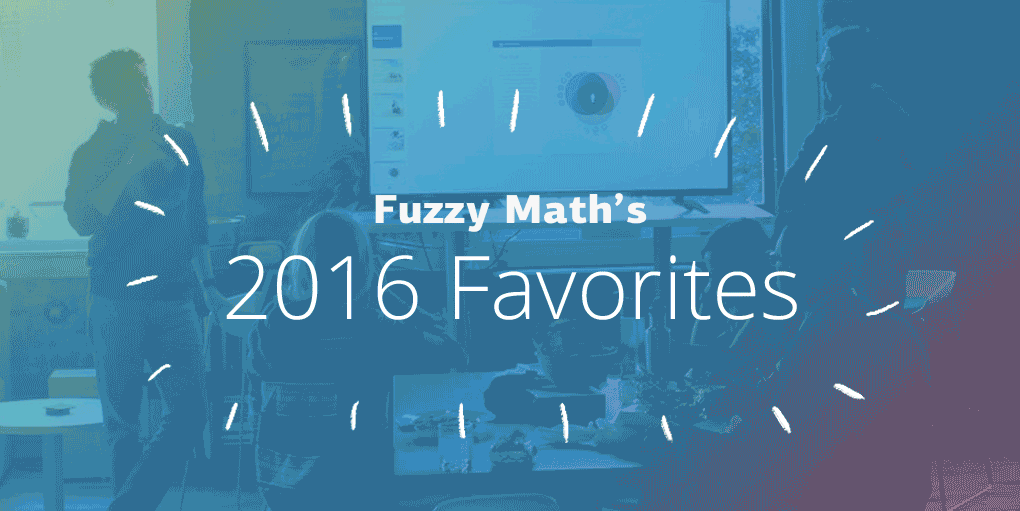
As another year at Fuzzy Math winds to a close, we’re camped out indoors, away from the single-digit Chicago temps outside, and reflecting on design throughout 2016. We’ve compiled a list of some of our favorite design articles, both from us and from other fantastic voices in the design community.
Happy holidays! We’ll see you in 2017.
Favorites from Our Blog
When to Push Innovation Over Usability: A Team Discussion
The team from Fuzzy Math sat down in our conference room to discuss when to push innovation over usability. We mainly discuss the balance between meeting users’ expectations so that the tool is easy to use versus pushing boundaries so we are offering unexpected accelerators. We concluded that UX design, like most things, is a spectrum. And offered the advice to focus on the user goals. Uncover user’s intent and find the best solution to meet that needs, expected or unexpected.
Create Successful Healthcare Technology by Understanding 3 Core Users
The rapid development of healthcare UX products, including those targeting hospitals, showed no sign of slowing in 2016, and we’re glad to have been involved with a number of products across that industry. Here, we’re exploring what it means to design for patients, administrators, and practitioners — three core users of hospital products.
Improve Accessibility for Users Who are Visually Impaired with These 9 Tips
As technology continues to evolve, we must continue to find ways to ensure that our products are usable by people of different backgrounds and abilities. In June, Fuzzy Math took a stab at identifying design principles that can be woven into our design process to improve accessibility for blind users.
Navigating the Human Mind
In our interface design process, we’re constantly thinking about the principles of cognitive processing that are shared by all humans – including how people make decisions and how people perceive the world around them. Based on these, we adhere to a set of visual principles that help us make our designs as usable and functional as possible. Take an inside look into how we understand cognitive processing and how we apply it to our designs.
Our Favorite Design Links of 2016
Applying User-Centered Design To Revamp A 75 Year Old Business Model
Ok, a bit of a shameless plug, but we were grateful to be featured in UsabilityGeek, especially as we got to talk about our work with our friends at Wonderlic.
Research: 44 percent say UX lacking with enterprise software
Enterprise software users find the software unusable, slow, and complex according to research. This comes as no surprise to the team at Fuzzy Math where we encounter enterprise end-users and software on a daily basis. While enterprise UX solutions are evolving and getting better, enterprise users are constantly comparing it to its consumer-facing counterparts with better UX. As we’ve been saying this for years, it’s time for the enterprise to get serious about UX in order to reduce costs, increase efficiency, and stay competitive.
Product Design: Your Product is Obsolete
In the continual march of technological innovation, the lure for customer attention and novelty of use is unavoidably strong. The success of an offering often hinges on the growing repeated use of a product. But, focusing on only the triggers and ease of use misses a fundamental to all great offerings: how customers interact with your offering will always change over time, but the underlying needs they have as humans rarely change. Products can no longer be just destinations or things people do. A great product is relational and sensitive to the actual problems and circumstances a person has in their lives.
The Scientists Who Make Apps Addictive
As product and service innovation continues to expand, so also does the influence those services have on the way people behave. If behavior is about what people do, companies need to be taking efforts not just on making people use their services more, but how coming alongside real people helps them succeed in their lives. Providing design to companies on behalf of users allows us to confront and engage with this important tension inherent in our work: that often there is a conflict between what people need and what a company needs. Advocating for the goals and needs of real people first makes products more responsible and valuable in the long-term.
Seven rules for perfect Japanese typography
Much of what is written about design for web is in an English language context. At Fuzzy Math, we’re always curious to grow and see the holistic picture of how web design can be applied across multiple languages. AQ, a digital product design studio in Tokyo, wrote a great article this year about Japanese typography on the web. We believe that keeping our eyes open for different approaches to design helps us become more mindful designers.
Encouraging Innovation: Drug Discovery and Clinical Trials
In the past few years, we’ve seen a large focus on service design. In the healthcare industry, in particular, understanding the larger hospital ecosystem and the interactions and relationships between multiple actors – doctors, patients, pharmacists, etc. is paramount to building a successful user experience. This article delves into the “human” side of healthcare innovation and the importance of focusing attention on the goals, needs, and emotions of doctors and patients alike in order to successfully provide a good user experience.
The Language of Modular Design
In 2016 at Fuzzy Math, we’ve built content websites utilizing a modular design system – a system that allows for flexible, re-usable components. We worked with our clients and developers to establish pattern libraries and commonly understood languages. In practicing modular design, we found that our efficiency as a team greatly improved – and it allowed for lots of (systematic) flexibility with our clients’ content and design. We think this article is a good resource for teams who are interested in practicing a modular design process.